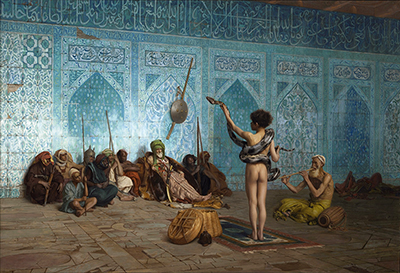The Snake Charmer, an 1879 oil-on-canvas painting, was produced by the French painter Juan-Leon Gerome.
After the work was used on Orientalism cover, a book by Edward Said, it gained a level of fame matched by very few Orientalist paintings. The painting became a lightning rod for Orientalism criticism, particularly Orientalist painting.
Provenance and Exhibition
In 1880, the artist's dealer Goupil et Ci sold the painting to the American patron of the arts Albert Spencer who sold the artwork to Alfred Corning Clark I in 1888. Clark loaned the painting for display at the World's Fair: Columbian Exposition held in Chicago in 1893. Clark's wife loaned the artwork to the Met (Metropolitan Museum of Art). In 1899, she sold it to Schaus Art Galleries. In 1902, The Snake Charmer was acquired by August Heckscher then required in 1942 by Robert Sterling Clark, Clark's son. From 1955, the painting has been in the Clark collection, an art museum and research institution in Williamstown, Massachusetts, US.
Subject and Setting of the Painting
The Snake Charmer depicts a naked boy who is standing on a carpet in the middle of a room that features blue-tiled walls. He is facing away from viewers while holding a snake. The snake is coiled around the waist of the boy and over his shoulder. The snake looks like a boa constrictor from South America, which was used to add a layer of hybridity in this painting. The artist studied this animal at the botanical garden Jardin des Plantes de Paris. To the right side of the boy sits an old man playing a fipple flute. This show is watched by a group of armed men from various Islamic tribes, with different weapons and clothes that appear dazed.
The scene depicts a European vision of life in the world of Islams. Gerome placed the performance in a fictional space deriving from identifiably Turkish and Egyptian sources. In the painting, the blue tiles were inspired by Baghdad Kiosk of Seraglio in Ottoman-era Constantinople. At the top of this painting, there is a large frieze that runs from right to left. It's a famous Koranic verse al-Baqara, which is the longest chapter of the Quran. The inscription thereafter is trimmed, and it's probably not a verse from the Quran, but a dedication to the chief Muslim religious and civil ruler (caliph).




